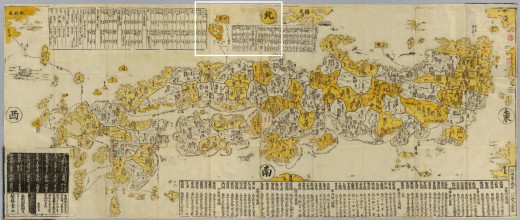Customs and Attitudes of the Japanese in the 16th & 17th Century
Japanese map around this time.


They Came to Japan
Customs and Attitudes; They Came To Japan
History is an interesting subject. Written subjectively, it is sometimes difficult to pull the objective facts about a situation and the things that happened in the most accurate way with little to no bias. Since it is impossible for every person to see history first-hand, it is important to find a way to get the most unbiased information about history and to present that to people for them to make their own assessment about what happened. In Michael Cooper’s They Came To Japan, we are presented with a multitude of different accounts of people from around the world (mainly Europe) that give their perspective of how life was in Japan from 1543 to 1640. With this method, we are able to get enough perspectives to be able to pass by the bias and see how the people really lived and how there culture was. One focus of the accounts in this book is the people of Japan, their daily life, and their customs.
Using multiple accounts from the book, it is pretty easy to pick up trends talked about. One example of this is the people of Japan. Joāo Rodrigues, Francesco Carletti, and Bernardino de Avila Girón all stated that the people of Japan were a pale-white color with small, dark eyes, small noses, and dark hair. The people also have a very high opinion of their values and themselves in general. St. Francis Xavier said, “The Japanese have a high opinion of themselves because they think that no other nation can compare with them as regards weapons and valour, and so they look down on all foreigners.” It’s interesting to hear about the self-esteem the people had and the confidence they had in their war abilities at this time. In my experience, most cultures fear foreigners and the unknown people outside of their borders. Since there probably weren’t many people that had traveled the world at this time in Japan, it’s interesting to see their confidence in themselves. Two other themes talked about in multiple excerpts form the book state that the people of Japan care the most about their “honor” than any other people they’ve seen and “fear death less than any other nation.” The accounts in this section of the book really emphasize the people as a confident race that thinks very highly of themselves. Their physical qualities are talked about by the Europeans, mainly relaying the differences between the Japanese and the Europeans. Then, the proceed this section of the book by also pointing out the face value of the people as a whole; their cultures main values and their out of the ordinary attributes.
Takeda Clan

Another specific topic talked explicitly about in this book is the daily life of the people of Japan. This includes everything from the food they usually ate to the way they kept time to the way they crossed land and water to hygiene and many other things. According to the Europeans the people of Japan had a very peculiar way of calculating things. “We count the hours from one to 12; the Japanese count them in this way: six, five, 4, 9, 8, 7, 6, and so on.” The Europeans go on to explain the odd fire-clocks the Japanese have, the additional months, the names of their years, the way they calculate age, and how they measure distances. Each calculation the Japanese do is done differently than what the Europeans are used to, and that is why it seems to be brought up by so many different people in the excerpts.
It is interesting to find throughout the book how many different people will bring up the same things about the people of Japan. Like stated earlier, this is one of the best ways to get an idea about how life was in the past. Having multiple different people say the same things across a large amount of time reassures us that this isn’t just an odd occurrence but is a typical thing in this time period. Going off this, we see that the Japanese had a particular was about mounting a horse, only mounting on the right side and using an iron bit in the horse’s mouth, and would cross the sea with many people in small boats standing while rowing. Finally, when referring to the Japanese daily life, we see hygiene brought up throughout the book from many different excerpts. The people all carried fans, washed themselves twice a day, had public baths, carried handkerchiefs, picked their noses with their small fingers (because of their small nostrils of course), used long toothpicks, cleaned their teeth, and used very different ways to cure the sick similar to what we see today (moxa and acupuncture). These excerpt brought to us by Luis Frois, Jorge Alvares, Joāo Rodrigues, Alessandro Valignano, Marcelo de Ribadeneira, Lourenco Mexia, and Richard Cocks helps us understand not only the daily life of the people of Japan, but their customs as a people that care about their hygiene, and have a particular way they live that is rarely deviated from.
Following this, we find more information about the food and drink, the education, and the religiosity of the people. Millet, rice instead of bread, and potatoes were their main food. They ate three times a day and used chopsticks. There were usually no public schools, only “the sons of nobles, lords, the aristocracy and gentlefolk learn how to read and write.” Religion was something brought up multiple times about the people as well. Buddhism was a large part of the people’s life, despite its origin in India. Religion is emphasized so greatly because it was a part of the people’s every day life. They would worship Shaka and many people made a profession or religion in the country.
This book covers such a wide variety of topics that it is easy to get a feel for how the Japanese were in this time period. The people of Japan between 1543 to 1640 as told by the European people value honor, have confidence in themselves and believe they are the strongest country when it comes to war. Their daily lives consist of eating things like rice, fish, potatoes and millet, counting time in a peculiar way, fishing, farming, and for some includes learning how to read and write. The customs of the people involves caring a lot about their hygiene, brushing their teeth, bathing daily, and using toothpicks, fans and handkerchiefs. They have a certain way to mount horses, ride in boats, and even sit. Everything they do has a certain way to be done correctly and they very rarely will deviate from that norm. According to the Europeans, the Japanese are friendly people that are welcoming to foreigners, but still see oddness in the way the Europeans do things. However, they aren’t afraid to learn new things from the foreigners such as new things to eat.
So, as stated earlier, history is a difficult thing to explain to people. Since every person has a bias, it is important that you get more than one account of something from the past to be able to get the most accurate reinterpretation of what actually occurred. They Came to Japan does just that. It gives us multiple different accounts of the people of Japan 400 years ago, their daily life, and their customs. With these multiple interpretations we are able to gather information that we can be confident in and can get a better grasp about how the people truly lived. For this reason, I thought They Came to Japan was a very interesting book to read, and would recommend it to anyone that wants to get a better and more accurate account of the history of the people of Japan 400 years ago.



